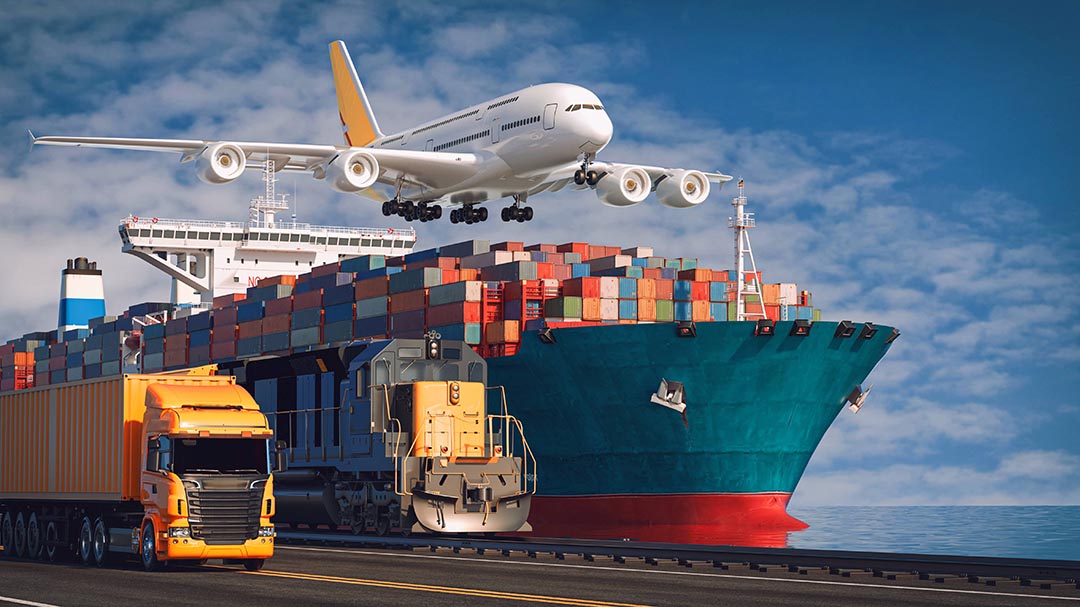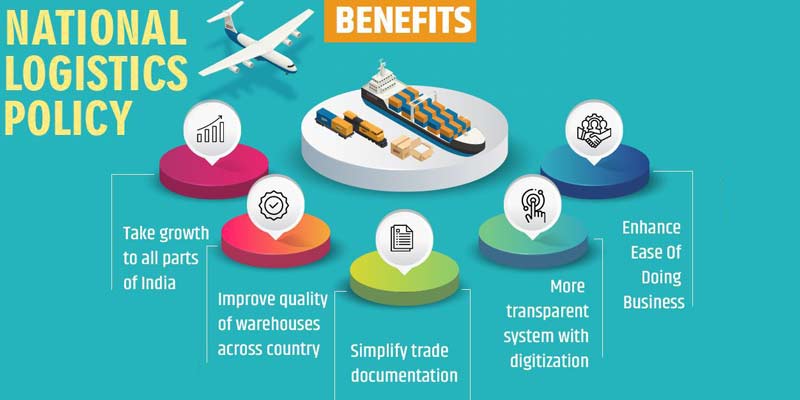Introduction:
The logistics sector forms the backbone of any economy by ensuring that goods and services reach their destinations on time and at a reasonable cost. For India, a rapidly growing economy with ambitions of becoming a global manufacturing and trade hub, logistics efficiency is not just an economic requirement but also a strategic necessity. Recognizing this, the Government of India launched the National Logistics Policy (NLP) on 17th September 2022. The policy was envisioned as a game-changer that would bring down logistics costs, reduce inefficiencies, and build a globally competitive logistics ecosystem.
- In the three years since its launch, the NLP has triggered reforms across multiple area, from digitization and infrastructure creation to regulatory alignment and workforce development. These efforts are in line with the PM GatiShakti National Master Plan, which integrates planning and implementation across different modes of transport. Together, these initiatives are gradually reshaping India’s logistics landscape, enabling smoother domestic supply chains and making Indian exports more competitive in global markets.
Key Objectives of the National Logistics Policy:
1. Reducing logistics costs: India’s logistics expenditure has traditionally been much higher than global benchmarks, making exports less competitive. The NLP seeks to bring these costs closer to the global average of 8% of GDP.
2. Improving India’s ranking in the World Bank’s Logistics Performance Index (LPI): The target is to place India among the top 25 countries by 2030.
3. Building a data-driven logistics ecosystem: By introducing digital platforms and data-sharing mechanisms, the NLP aims to ensure informed decision-making for both government and private stakeholders.
4. Strengthening soft infrastructure: The focus is not only on physical projects but also on regulatory reforms, skill development, and institutional mechanisms to sustain growth.
Major Achievements of NLP (2022–2025):
Digital Transformation and Data Integration
· Unified Logistics Interface Platform (ULIP): API integration across 30+ systems; 160 crore+ transactions enabling transparency and faster cargo movement.
· Logistics Data Bank (LDB): Tracked 75 million+ EXIM containers across 101 ICDs, improving real-time planning and reducing delays.
· E-Logs Portal: 35+ industry associations registered; resolved 100 of 140 issues raised.
State-Level Logistics Reforms
· LEADS Index evolved with corridor access, terminal speed (2024) and digital adoption, sustainability metrics (2025).
· Improvements contributed to India’s rise to 38th rank in World Bank’s LPI (2023).
Recognition and Innovation
· LEAPS initiative rewards innovation by startups, MSMEs, and academia in green logistics, automation, and ESG, aligning growth with global goals.
Green and Sustainable Logistics
· Transportation Emissions Measurement Tool (TEMT) by IIM Bangalore: ISO 14083-compliant, cloud-based emissions tracking.
· Push for renewable energy, electric fleets, and energy-efficient infrastructure in logistics.
Infrastructure Development
· Multi-Modal Logistics Parks (MMLPs): Integrated hubs with warehousing, customs clearance, cold storage, packaging.
· Service Improvement Group (SIG): Institutional mechanism to resolve regulatory and policy issues swiftly.
Skilling and Capacity Building
· 100+ universities introduced logistics courses; Centre of Excellence (SPA Bhopal) trained 100+ officials.
· 65,000+ professionals trained (2023–25); MoU with GatiShakti Vishwavidyalaya for UG/PG programs.
· 250+ workshops for officials; digital courses on iGoT platform.
Sector-Specific Logistics Policies
· Sectoral Policy for Efficient Logistics (SPEL): Frameworks for coal, cement, steel, food processing, pharma.
· Coal Logistics Policy and Integrated Coal Logistics Plan implemented; Cement SPEL finalised; draft steel, fertiliser, food processing policies underway.
Inclusion and Gender Participation
· DPIIT–GIZ study on women’s participation in logistics under review to guide workplace inclusivity reforms.
State and City-Level Action Plans
· DPIIT guidelines for City Logistics Plans (CLPs) to reduce congestion and pollution.
· 27 States/UTs have logistics policies; 14 preparing action plans; 19 granted industry status to logistics with tax incentives.
Growth Drivers of India’s Logistics Sector:
1. Policy and Regulatory Reforms: The combined effect of NLP, PM GatiShakti, and GST has reduced fragmentation and improved efficiency. Logistics costs have already dropped by 0.8–0.9% of GDP between FY14 and FY22.
2. Infrastructure Expansion: Major projects under Sagarmala, Bharatmala, and the National Infrastructure Pipeline (NIP) are creating multimodal connectivity. 35 MMLPs are under development with a planned investment of ₹50,000 crore.
3. Digital Transformation: Adoption of tools like RFID, GPS tracking, blockchain, and digital twins is improving transparency. India’s jump to 38th rank in the LPI highlights these gains.
4. Manufacturing Growth: With Make in India and PLI schemes, manufacturing is creating new demand for agile logistics. Manufacturing accounted for 15.3% of GDP in FY22 and is projected to grow with global supply chain shifts like the China+1 strategy.
5. E-commerce Boom: India’s e-commerce market is expected to touch $200 billion by 2026. Logistics services are projected to grow from $435 billion in FY22 to $591 billion in FY27 (EY), driven largely by last-mile delivery and reverse logistics.
6. Employment and Skilling: The sector currently employs 22 million people, with another 10 million jobs expected by 2027. Organised logistics players are projected to grow at a 32% CAGR.
7. Sustainability Push: The expansion of freight villages, coastal shipping corridors (e.g., Sagar Sethu portal), and ESG-compliant supply chains is turning sustainability into a growth driver.
Key Challenges in India’s Logistics Sector:
· High costs: Logistics accounts for 14–18% of GDP, compared to 8% globally.
· Modal imbalance: Roads handle 66% of freight, while rail carries 31% and waterways only 3%.
· Infrastructure deficits: Land acquisition delays and clearance hurdles slow down projects like DFCs and MMLPs.
· Regulatory complexity: Multiple ministries and state rules cause duplication and delays. Compliance can account for up to 25% of logistics delays.
· Digital divide: Smaller operators struggle with adopting RFID, IoT, and AI tools.
· Skilling gaps: Over 90% of the workforce is unorganized, limiting productivity and safety.
· Environmental concerns: Logistics contributes 14% of India’s CO₂ emissions, and green transport remains underutilised.
The Way Forward:
1. Accelerate Integrated Infrastructure: Full-scale implementation of PM GatiShakti and NLP to ensure multimodal connectivity.
2. Cluster-Based Logistics Hubs: Develop MMLPs near industrial corridors with warehousing, cold chains, and customs clearance.
3. Digital Logistics Push: Expand adoption of ULIP, E-Logs, and ICEGATE among small operators with incentives.
4. Shift Freight to Rail and Waterways: Offer policy incentives for moving bulk cargo through greener modes.
5. National Logistics Workforce Mission: Launch structured skilling programs linked with employment opportunities.
6. Formalise the Unorganised Sector: Simplify compliance and provide low-cost finance to small logistics players.
7. Adopt AI and Geospatial Intelligence: Use predictive analytics to monitor congestion, bottlenecks, and supply chain risks.
Conclusion:
The National Logistics Policy has already set in motion a wave of reforms that are reshaping India’s logistics sector. By bridging infrastructure gaps, enabling digitisation, encouraging sustainability, and focusing on skills, India is positioning itself as a global logistics leader. Yet, challenges like high costs, modal imbalance, and uneven tech adoption persist. The way forward lies in deepening reforms under a “Whole of Government” approach, ensuring centre-state cooperation, and encouraging private sector innovation.
| UPSC/PSC Main question: India’s logistics transition towards renewable energy and electric fleets is still at a nascent stage. Critically analyse the feasibility and economic implications of this shift. |








